I’ve always felt that one way to judge the popularity that the WECA heroes had during the time that these comics were on the stands (1941-46) would be to look at the number of central cover billings that each one of them got. Today, we are looking back at this era after seven decades and assign special prominence to characters using eyes and attitudes and tastes that have fed on four or five comic era strata and several iterations of moral, cultural, and info-technical “advances.”
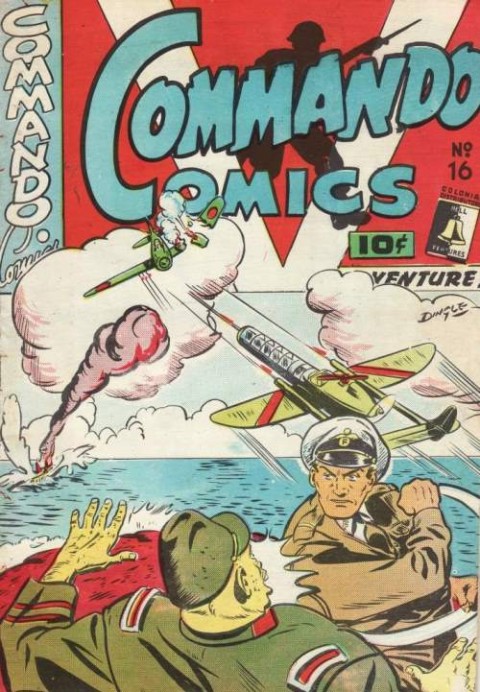
For this post let’s stick to the Bell heroes as they appeared on the cover of six of the seven titles; we’ve got to make an exception of The Funny Comics because it featured one central character, Dizzy Don, who got every cover appearance for the 20 issue run with Bell. Also, the first 13 issues of Commando Comics feature generic soldier covers as one would expect and there are a couple of more generic soldier covers in the runs of the other titles (e.g., Dime 18 and 19, Wow 21). So let’s just look at the covers for the runs of Wow, Triumph, Dime, Active, and Joke Comics and see which characters are most featured on their covers.
When the first and only title was Wow Comics, Edmund Legault simply put Dart Daring on every cover, but when Dime and Active Comics came out in Feb. of 1942 (about the time of Wow Comics No. 5 by my estimation), Edmond Good was Art Director and maybe he chose the central cover figure. But by May, 1942 Adrian Dingle had been hired as Art Director and he brought Triumph Comics along with him from Hillborough Studios. From that point on, Dingle was probably making the cover decisions and, in fact, illustrating the majority of them. Throughout this time it’s not clear if Cy Bell had any input as to which hero would be the central figure on each of the covers.
We also know that by 1945 Cy Bell chose to issue a handful of compendium books that included a collection of the text stories from earlier books called Thrilling Stories for Boys, and five other books that each brought together stories of The Phantom Rider, Tang, Spike and Mike, Speed Savage, and Nelvana.
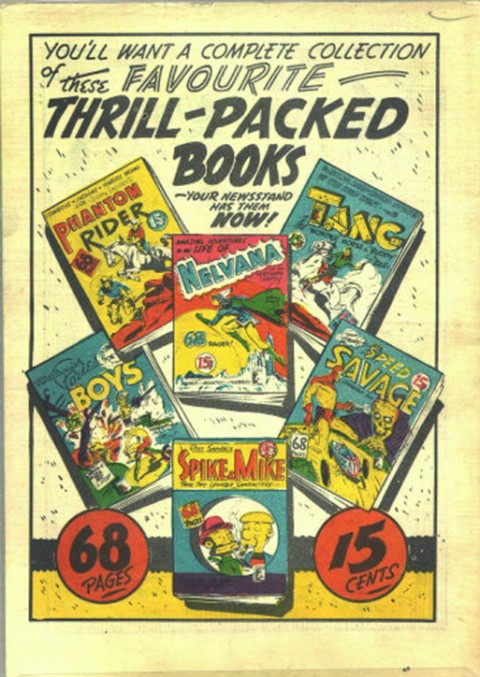
Each one of the hero ones probably contained at least one new, previously unpublished story. But in our context, the important thing to notice is that around the end of the war these must have been the most popular Bell Features characters.
Looking at the run of covers in the six Bell titles excluding The Funny Comics, we find that Rex Baxter had the most central cover features at 16, all in Dime Comics.
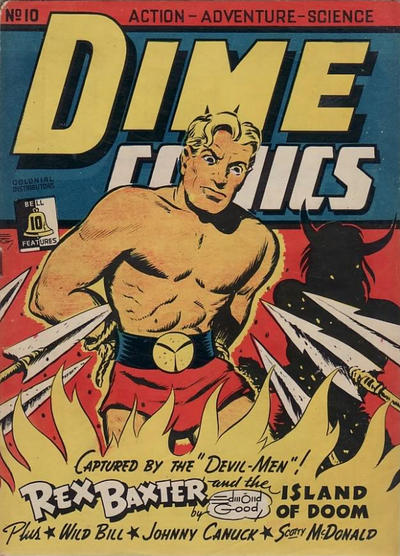
He appeared on the first 14 issues of Dime plus issues 21 and 28, more than double the appearances of the next nearest characters, Speed Savage who appeared on 8 Triumph Comics covers (#s 9, 14-15, 17, 20, 22, 26, and 29).
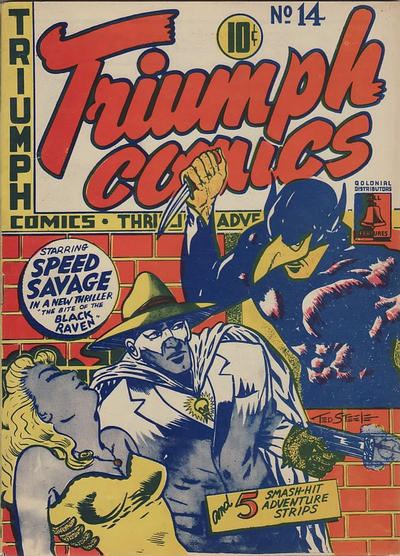
And Nelvana who appeared on another 8 covers of the same comic (#s 2, 7, 12, 18, 21, 25, 27, and 30).
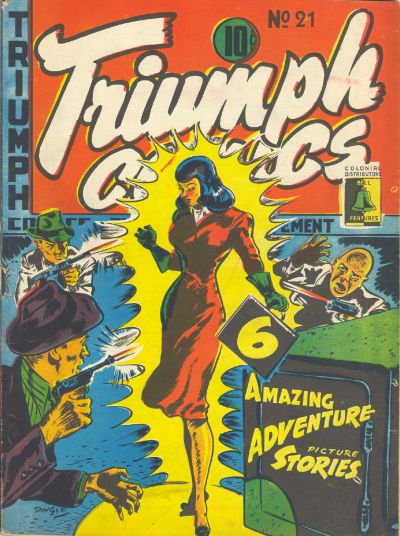
Is this an indication of popularity? Cy Bell was always asking for letters and feedback from readers as to which features and characters they liked the most, so perhaps he or Dingle were guided by this indicators when they chose central figures for the covers.
There are a number of characters with seven central cover appearances. Alphabetically they are: Dart Daring (Wow Comics 1-6, and 11); Dixon of the Mounted (Active Comics 1, 4, 6, 9, 10, 14, and Triumph Comics 24).
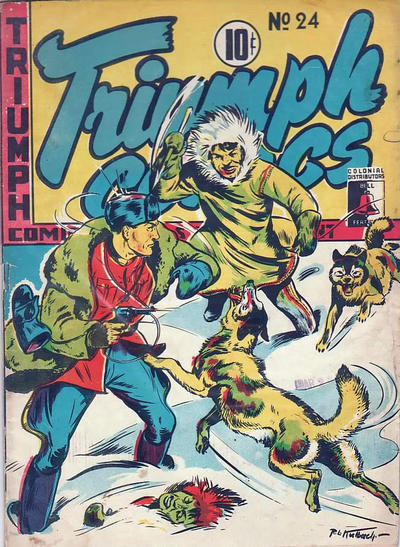
Private Stuff (Joke Comics 3-5, 9, 10, 15, and 17). Close behind with six appearances are The Brain (Active Comics 3, 8, 13, 17, 22, and 25).
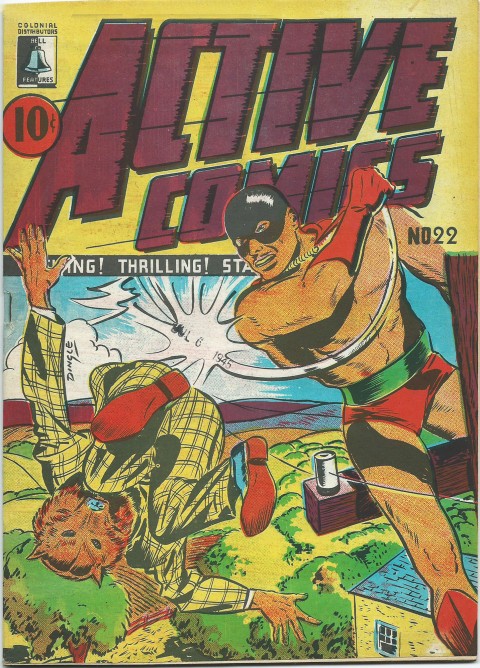
The Penguin (Wow Comics 16-19, 23, and 25), Spike and Mike (Joke Comics 6-8, 16, 19, and 24), and Tang (Triumph Comics 3, 8, 11, 13, 19, and 23). Crash Carson, Jeff Waring, and Thunderfist only had 4 covers each and Capt. Red Thortan, Dr. Blue and Blackie, Drummy Young, Nitro, and The Wing 3 each.
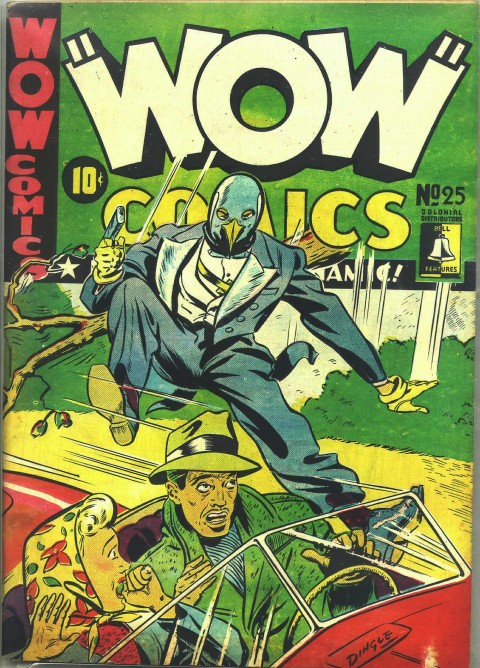
The glaring omission is Johnny Canuck who, though amongst the highest profile WECA heroes looking back on this period, NEVER received a top cover billing and didn’t merit a compendium in 1945. He did, though, have a couple of 1946 reprints of non-Canadian material named after him and the cover image was a reprint of the Nels Grant cover by Clayton Dexter from Triumph Comics No. 28.
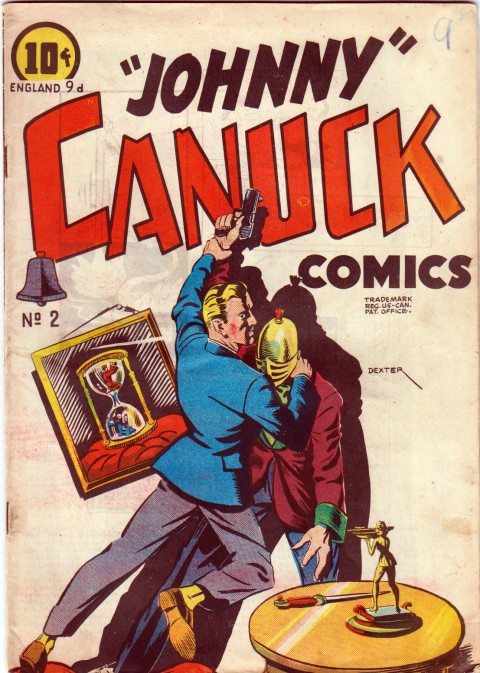
What, then, can we surmise from this Bell Features cover landscape? The war, of course, permeated these comics and this is reflected in the number of covers that had a soldier, airplane, or espionage theme. If we look at all, roughly 190, covers of the seven main titles issued by Bell Features only 44 have a costumed super hero on the cover, meaning that a superhero appeared on the cover of only every fifth issue or so or just over 20% of the time. Yet, it seems to me that, after 70 years, these are the comics that we pay most attention to and that are probably the most collectible.
This is a fact of collecting. Joker covers are the most collectible issues of Detective and Batman Comics, aside from the obvious keys, of course and Nelvana (followed by The Penguin, Thunderfist, Nitro, and Speed Savage as the White Mask) covers appear to be among the most collectible of the Bell Books. Even with the other WECA publishing companies, the costumed hero covers (Iron Man, Brok Windsor, Freelance, Commander Steele, and Canada Jack) seem to be the most collectible issues, again aside from Number 1 keys, etc.
Super heroes were only the tip of the iceberg of what the WECA Whites were about, yet it seems to be the sharpness of this tip that affects us the most today. Even when the war ended there were still about 18 months of Bell Features comics to come out, but the super heroes didn’t take over and none of the former non-costumed heroes became costumed (Rex Baxter became a counter spy, The Young Commandos were reduced to civilian investigators Ruff and Reddy, and Whiz Wallace became a test pilot, even Nelvana gets an alter ego in the form of Alana North and a job as a secret agent) except for one: Doc Stearne became Mr. Monster in the very last panel of his story in the last issue of Triumph Comics.
One thing I noticed in this investigation was that towards the end of the Bell Features WECA run a couple of covers got a little mixed up and were unrelated to the contents of the books they represented.
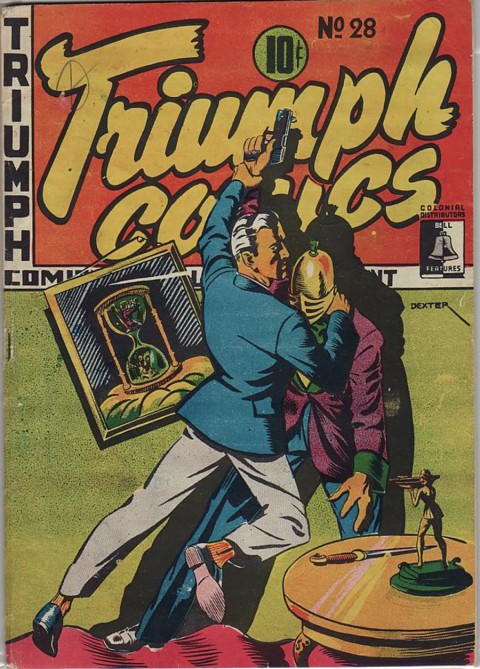
For example, the Nels Grant cover drawn by Clayton Dexter on Triumph Comics 28 better belongs on the previous issue, No. 27 but Dingle opted out for his own cover representing the encounter of Alana/Nelvana with the Staticites who appear in the Nelvana story.
The other misplaced covers are those for Commando Comics 20 and 22. Commando 20 features a cover that has nothing to do with its own content but represents a Grant Randall story that appears in Triumph Comics No. 29.
Commando 22 has the same problem with a cover not connected to anything in it but instead represents Fred Kelly’s “Ju-Ju Swamp” story in No. 31. Fred Kelly must have done these covers for Triumph Comics originally but Dingle went with his own covers and perhaps decided instead to use them on the Commando issues. I wonder if we’ll ever find out the reasons behind this juggling?

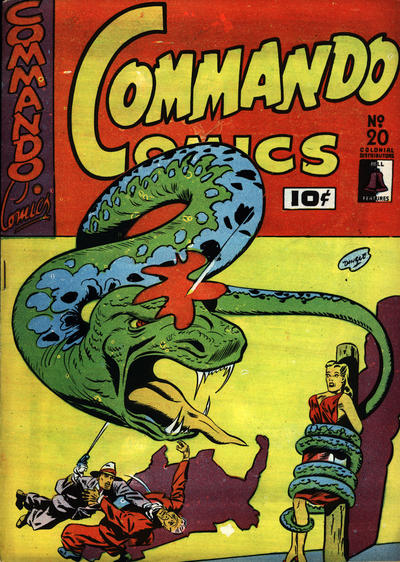
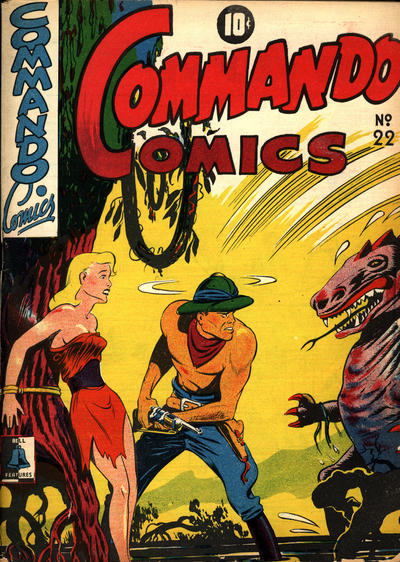



An interesting article Ivan that brings out the detective in me and makes me want to subtitle it: Canadian Whites Office Politics 1942-46? ..hmmm
With all this Edmond Good OA of late in the 1942 and on time period both in pulps and his later work on the Sky Rangers he looks like he kept himself busy after Adrian Dingle took his job as part of the sale of Hillborough Studio to Bell.
Later in the tail end of the Canadian Whites era at Bell I imagine there was some turmoil between management and soon to be out of work artists.
Perhaps some deadlines for covers were missed and drastic action had to be taken by Adrian to keep the production going until the very last book even if it meant any cover used that was ready if some artists were busy looking for other employment.
It could also explain some of the reuse of covers to generate more money on later issues.
If I was actually The Dreamer i might know the answers to this mystery, but I am not 🙁
Unless Hugh Dunnit or the Penguin can chime in on this bit of “office” intrigue it looks like we may never know.
You are right, Jim. This “twilight” period of the WECA books needs to be explored a lot more. The publishers seemed to have gone from treading water to thrashing around for survival under the avalanche of American comics coming back into the country. You can see this in the carelessness of some of the covers, in the move to full colour, into the move towards funny animal and American feature reprints, as well as some of the redraws that Bell seemed to be doing (see the Jo-Jo original art from my Apr. 30 post “From the Archives”–Gerald Lazare even remembers doing a “Master Key” story, also possibly a redraw, around this time). Cy Bell was also getting his creators to sign over the rights of their characters to Bell Features around this time. I wonder if we’ll ever be able to uncover what really happened but what we can surmise from the “archaeology” at hand is that there indeed was some sort of turmoil going on.
There is an octopus in one of the Nelvana stories and one as the main subject on the Adrian Dingle cover of Dime Comics#22, also reprinted as the cover of Bell’s Unusual Comics #2.
Do you think the chances are good that this one may have been intended for the issue of Triumph Comics with that Nelvana story at one point?
And if you want to count those covers that were used twice, you can give The Wing one more (for 4 covers) as she was on one re-used for a cover of one of the ‘new line-up’ titles, FBI.
~jim b.
Not in the case of Dime Comics #22, Jim. There is a six-page story in that issue by Fred Kelly called “Monsters of the Deep” which is about deep sea divers and how one of them encounters a giant octopus. I’d forgotten that the second issue of FBI Comics used that Wing cover from Joke Comics #23, thanks for bringing it up.
Okay, thanks for the further info Ivan.
By the way, do you know what was on the cover of the first issue of Bell’s FBI Comics? I’ve never seen one of those.
There seems to be very little information around on the later Bell comics, beyond what is listed on the National Archives site and they don’t offer images on the web, …sigh.
My uncle went by the name of Kurly Lipas and had a strip in Active Comics issue #13. King Fury.
Would there be a copy of this available anymore or were any more comics books he may have been in?
Thanks for writing in Kevin. Your uncle is someone I’m trying to find more information on. He did do the strip “King Fury” in Active Comics 13-17. I’ll send copies along to you.
Correction to that caption under the first cover pic above. That is not a generic war cover, in fact, that “F” on the cap means that that is Clift Steele, skipper of the “Freedom” sub and created by Al Cooper back in Commando Comics No. 1.